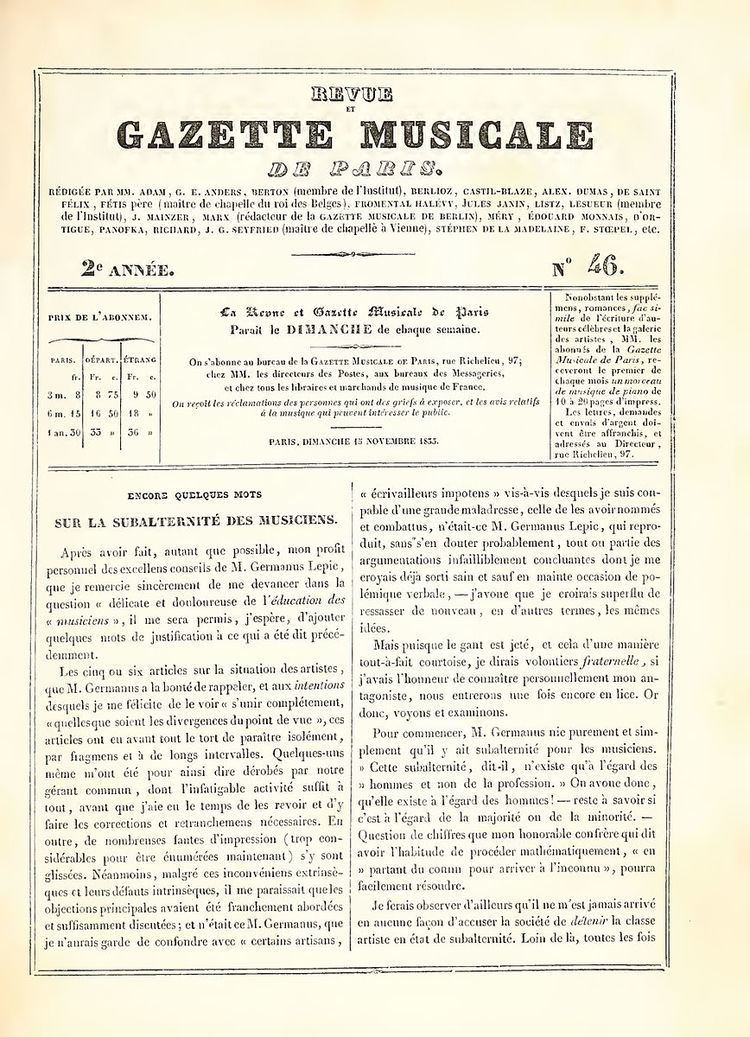 | ||
The Revue musicale was a weekly musical review founded in 1827 by the Belgian musicologist, teacher and composer François-Joseph Fétis, then working as professor of counterpoint and fugue at the Conservatoire de Paris. It was the first French-language journal dedicated entirely to classical music. In November 1835 it merged with Maurice Schlesinger's Gazette musicale de Paris (first published in January 1834) to form Revue et gazette musicale de Paris, first published on 1 November 1835. It ceased publication in 1880.
Contents
History
By 1830 the Revue musicale, written and published by Fétis, was on sale at Maurice Schlesinger's music seller's premises. Schlesinger (whose father founded the Berliner allgemeine musikalische Zeitung) was a German music editor who had moved to Paris in 1821. Schlesinger published editions of classical and modern music under his own name at a reasonable price, most notably works by Mozart, Haydn, Weber, Beethoven, Hummel and Berlioz. He also published Robert le diable and Les Huguenots by Giacomo Meyerbeer, as well as La Juive by Fromental Halévy. Schlesinger founded his own rival publication, the Gazette Musicale de Paris, which first appeared on 5 January 1834.
Another music journal, Le Ménestrel, had first appeared the previous month on 1 December 1833. Until La Revue et Gazette ceased publication in 1880, Le Ménestrel was to be its main rival in terms of influence and breadth of coverage.
In 1835, Schlesinger bought the Revue musicale from Fétis and merged the two journals into the Revue et gazette musicale de Paris. He widened the subject matter of the Gazette musicale from music itself to also include literature about music – in 1837 he commissioned from Honoré de Balzac for the Gazette the novella Gambara (dealing with the new style of grand opera).
The name Revue musicale returned for six months in 1839 as the Revue musicale, journal des artistes, des amateurs et des théatres while the journal was a bi-weekly publication. The list of contributors to the Revue et gazette musicale in 1840 included: François Benoist, Hector Berlioz, Castil-Blaze, fr:Antoine Elwart, Stephen Heller, Jules Janin, Jean-Georges Kastner, Franz Liszt, Édouard Monnais (director of the Paris Opera from 1839 to 1847), Joseph d'Ortigue, Theodor Panofka, Ludwig Rellstab, Georges Sand, Robert Schumann, and one Richard Wagner.
Publication chronology, 1827—1850
Published by Fétis. First series (6 volumes):
Second series (14 volumes):
Published by Schlesinger, appeared on Sundays.
Appeared on Sundays.
Schlesinger sold the journal in 1846 to a former employee, Louis Brandus.
The journal was suspended from September 1870 to September 1871 during the Siege of Paris, bringing the Franco-Prussian War to an end.
